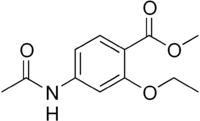Ethopabate
Ethopabate
 |
| Names |
| IUPAC name
methyl 4-(acetylamino)-2-ethoxybenzoate |
| Identifiers |
| |
59-06-3  Y Y |
| 3D model (Jmol) |
Interactive image
Interactive image |
| ChEMBL |
ChEMBL458769  Y Y |
| ChemSpider |
5812  Y Y |
| ECHA InfoCard |
100.000.377 |
| KEGG |
D08916  Y Y |
| PubChem |
6034 |
| UNII |
F4X3L6068O  Y Y |
InChI=1S/C12H15NO4/c1-4-17-11-7-9(13-8(2)14)5-6-10(11)12(15)16-3/h5-7H,4H2,1-3H3,(H,13,14)
Ethopabate is almost odorless white to pale reddish white powder. It is freely soluble in chloroform,
soluble in methanol or ethanol, very slightly soluble in ether, and practically insoluble in water.
Ethopabate is designated as a feed additive to promote the effective use of nutrient components
contained in feeds, and the ordinance of MAFF allows the use of it in the range of 2.56-16 g/t in
feeds for starting chicks, growing chicks, prior stage or later stage broiler chickens (up to 7 days
before killing for edible use). Further, use of ethopabate at a concentration of 5 g/t is approved for
three-combination with amprolium and sulfaquinoxaline in formula feeds for chickens.  N NKey: GOVWOKSKFSBNGD-UHFFFAOYSA-N  Y YInChI=1/C12H15NO4/c1-4-17-11-7-9(13-8(2)14)5-6-10(11)12(15)16-3/h5-7H,4H2,1-3H3,(H,13,14) Key: GOVWOKSKFSBNGD-UHFFFAOYAO
|
CCOC1=C(C=CC(=C1)NC(=O)C)C(=O)OC O=C(Nc1cc(OCC)c(cc1)C(=O)OC)C
|
| Properties |
| |
C12H15NO4 |
| Molar mass |
237.25 g/mol |
| Pharmacology |
| |
QP51AX17 (WHO) |
Except where otherwise noted, data are given for materials in their standard state (at 25 °C [77 °F], 100 kPa). |
 N verify (what is N verify (what is  Y Y N ?) N ?) |
| Infobox references |
|
|
Ethopabate is a coccidiostat used in poultry.[1]
References
